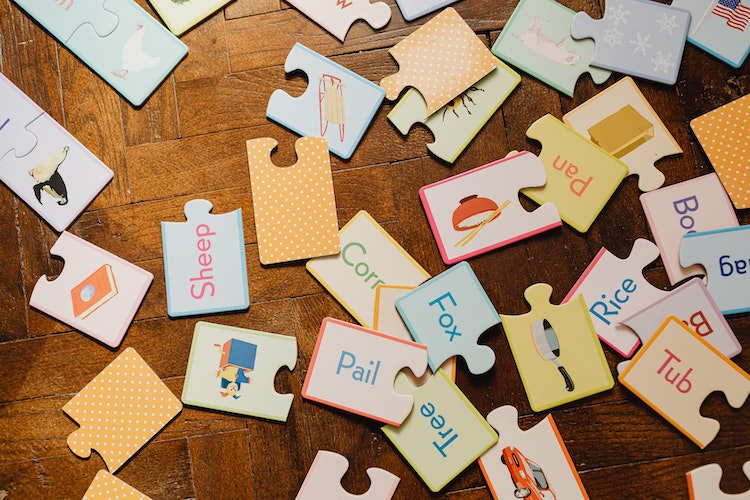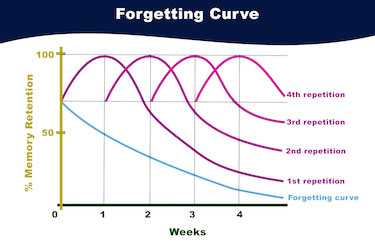The memory is the complex process in the brain that enables us to acquire, store and retrieve stored information later when we need it. Without memory, we would be unable to carry on our normal lives, learn anything new or even remember who we are!
Everything that we do and everything that we think requires the use of memory; from riding a bike to remembering the names of relatives or someone we have just met.
The best known types of memory function are long-term memory where you can remember back to your childhood for example and short-term memory for information which is more recent.
As we all know, the memory is rarely perfect but as the mind has to go some through ultra-fast processing this is hardly surprising. The memory requires the brain to encode the information, store it away and then retrieve it when we need it, all in a matter of split seconds.
It only takes a few seconds to store a memory and this means that forgetting is a very common event.
If you cannot remember where you put your keys, or have forgotten somebody's name, it could be that your memory failed to store this information. However, it could be that you failed to concentrate because of other interference – such as thinking about something else or being overloaded with other information.
It is perfectly normal to forget things sometimes, but the good news is that you can take steps to improve your memory by making some simple lifestyle changes.
If you are struggling with your memory, improving physical fitness will help.
Getting more active improves memory
According to neurological research, exercise boosts thinking skills. Studies have shown that the parts of the brain which control thinking and memory are larger in volume in people who exercise than in those who don't.
Exercise also encourages the production of growth factors and new brain cells, helps the brain manage hormones such as insulin and reduces areas of inflammation. Studies show that people, who took up moderate exercise such as walking, improved their brain function within six months to a year, so if you want to improve your mental cognisance and memory start getting more active now!
As well as these neurological benefits, exercise also helps reduce anxiety and improves sleep; two factors that have a negative effect upon memory function.
Researchers suggest that you should aim for at least 150 minutes a week and continue being active for life. Improvements to memory and brain will not happen immediately but will definitely bring improvements over time. As doctors say, if exercise were a pill, they would prescribe it to everyone!
Diet is important for memory
Diet is also important for healthy brain function and memory. Food which is high in low density lipoprotein (LDL) cholesterol, often known as bad cholesterol builds up in the arteries and speeds up the formation of plaque which clogs arteries and prevents blood flow. This has been long well known as a contributor to heart disease, strokes and diabetes but scientists are now realising there is a link between heart health and brain health.
To stay mentally sharp and physically fit, it is important to consider your diet and cutting down on red meat, sugars and trans fats such as those present in fast food and takeaways will help.
Improving your nutritional content by adding foods high in omega 3 oils such as oily fish, and increasing veg and fruit content, delivers vital nutrients to the brain. Adopting a more Mediterranean style of diet is generally considered good for health and for brain function.
Get familiar with Brain Superfood
Why is a good memory so important for learning?
A good memory is crucial for learning. A good working memory enables you to store new information and retrieve it when you need it. Without the ability to concentrate and focus on the subject, vital information is unlikely to be stored correctly.
Some people believe that a having a good working memory is only relevant when recalling facts, such as important dates, but the truth is that it affects everything. If for example, you fail to remember the necessary steps of a process or calculation, you will never be able to easily carry out even a basic sum.
Memory issues can affect all ages. Teachers are concerned that many children lack memory skills and have a very limited concentration and attention span. For older students and adults the problem can be the same. The relationship between learning and memory is closely intertwined. According to the American Psychological Association,
“Learning means securing various skills and information, while memory relates to how the mind stores and recalls information. It is almost impossible for an individual to truly learn something without also having the memory to retain what they have learned.”
Luckily, there are some proven techniques for improving memory and strengthening memory function for study and for everyday life. Let's take a look.
1. Mind Palace/Memory Palace
Also called the method of Loci (the Latin word for place), this method for improving memory was devised by the ancient Greeks and is still used today, especially by people who compete in memory competitions.
The idea is that you change your memories into images that you place into a familiar mental location such as your childhood home or an imaginary location. So for example if you need to remember something, you create a mental picture of it, within the memory palace and by walking through this mental landscape you will notice the symbol of the thing you are trying to remember.
This technique can be used to remember sequences of numbers, so for example – five red hats, 12 chickens, 100 pints of beer..., all placed in your mind palace and will be ready for recall.
It can also help you remember to do specific jobs such as picking up something on the way home for work or remembering someone's name. The trick is to make a strong association between an image and a fact in order to recall it effectively when it is needed.
Understand the Mind Palace in detail
2. Spaced Repetition, Flashcards, ANKI, regular active recall
It only takes a few seconds to create a memory but if you do not go back to it, the chances are you will forget it, especially if it is not very interesting to start with. If you are studying, spaced repetition helps you make sense of an overwhelming quantity of information, so you can store the important facts.
Spaced repetition is a fantastic way to reinforce the memory. The idea is that you tell your brain what it needs to store, and you do this by revisiting this information on a regular basis.
Flash Cards
An easy way to carry out spaced repetition is using flash cards. To do this, you create a box of flash cards that ask a series of questions relevant to what you need to learn.
You set up schedules for when you need to revise a certain subject and work through these on a regular basis. If you get the answer right, put the card in a box as a section that doesn't require as much attention. If you get the answer wrong, move the card to a section for frequent revisits.
Doing this is an effective way to strengthen your memory because it enables you to focus on the subject, and it improves active recall.
If you prefer to go down the digital route, there are apps to help you do the same thing without using physical cards.
ANKI
ANKI is a program that can be used for all types of learning including learning languages, studying for medical and law degrees, remembering names and faces, long poems, geography and anything else you need to recall.
ANKI works in the same way as the flash cards but is in a digital format. There are thousands of cards and the program supports images, audio and scientific mark up which helps to strengthen memory recall.
Many people have used ANKI and according to its many users, the program guarantees memory with minimal effort.
ANKI is available in all formats. It is compatible with PCs and Macs and can also be downloaded as an app to android and IOS.
Read more about the concept of Spaced Repetition
3. Acronyms and Mnemonics
A mnemonic is a way to improve memory and remember things in order and although this can refer to processes such as the mind palace, it is most usually associated with acronyms.
Acronyms are words which are made up by taking the first letter of each word you want to remember and putting them together to form a new word that creates a mnemonic.
Here are some common examples:
- NEWS – North, East, West, South: the points of the compass.
- BEDMAS – Brackets, Exponents, Division, Multiplication, Addition, Subtraction: the order in which you should approach a maths problem that has multiple calculations.
- PEN - Proton, Electron, Neutron: the parts of an atom
- SCUBA – self-contained underwater breathing apparatus.
An acronym can get out of hand. The use of too many acronyms becomes confusing, as has been seen in the recent BBC drama Line of Duty. However, they can be a useful aid to memory.
Mnemonics do not need to be used to form a word in order to help learning and many of these can be memorised in a way that lasts for years.
Some examples of mnemonics include;
- Mirror Signal Manoeuvre – the first steps to be taken when pulling off in a car
- Richard Of York Gave Battle In Vain – the colours of the spectrum in order. So Red, Orange, Yellow, Green Blue, Indigo, Violet
- Every Good Boy Deserves Fun : AGBDF – the notes of the treble clef
4. Chunking
Chunking refers to the process of taking pieces of information and grouping them together into chunks of larger units. A commonly used example of this is for remembering phone numbers. Most of us struggle to remember 6 numbers but find it much easier when grouping into 2 units such as 342 – 298. In European countries people tend to chunk phone numbers in groups of 2 such as 34 – 22 – 98.
According to neuroscientists, most people can remember 4 chunks of information but recall does get easier with practice.
So, if you want to remember a lengthy shopping list for example, grouping similar household items together may help, such as vegetables, grains, dairy and meat.
Chunking also works well for language learning when you can create small groups of words together that are related in some way.
With chunking, practice makes perfect, and you can increase the number of objects you can remember. Finding a way to group the objects together will help you remember them all either by visualisation or by a connection such as a mnemonic or by some other method personal to you.
5. Use as many senses as possible, reading, writing, speaking, hearing
Using as many senses as possible will help you remember information. So writing down that shopping list or essay and reading it out loud will help you remember it far more effectively than expecting to remember the information in just one hit. Listening carefully to a lecturer and taking notes at the same time helps you remember the information.
Repetition always helps memory so using different methods will further reinforce the message and the recall. Your senses are connected to your brain via the sensory nervous system, so they do play a major part in recall. The more senses you use, the more you will remember the information.
For actors learning lines for example, the process is made far easier if they include the hand movements and gestures. You can do the same when trying to learn complicated information and accompany it by speaking to yourself and making the appropriate gestures.
6. Draw mind maps, and visualise the information, using colours and handwriting
Creating a mind map is a good way to grasp the overview of the information you are trying to learn and to remember. It helps simplify the thought process, so it helps you understand the whole concept, rather than separate and disparate items of information.
To create a mind map, you should put the central idea at the heart of your design. Then add the key themes as the central branches which flow into the centre. You can add smaller branches and associations as you think of them and by using different colours and handwriting; you can free your brain's creativity, giving you different ways to think about your subject.
Keeping the mind map simple by using keywords and different colours for different processes, will help keep the mind map clear.
You can add images or other visual stimuli to a mind map which will help your brain make shortcuts. In addition, by creating a mind map it enables you to see connections that may have been undiscovered.
Because a mind map is such a fun and creative exercise, it enables your mind to take in more information far more easily than simply relying on using just one sense.













